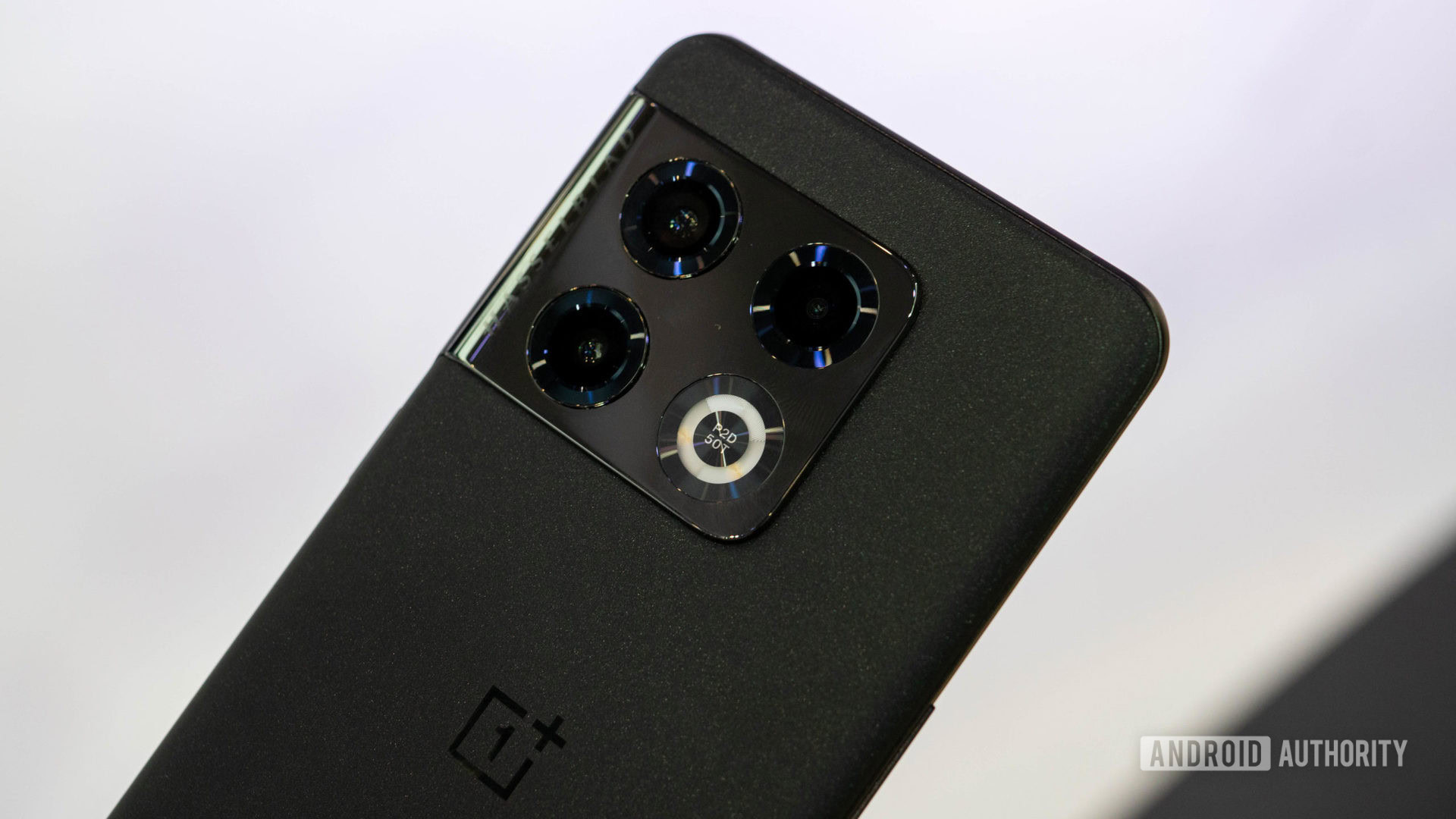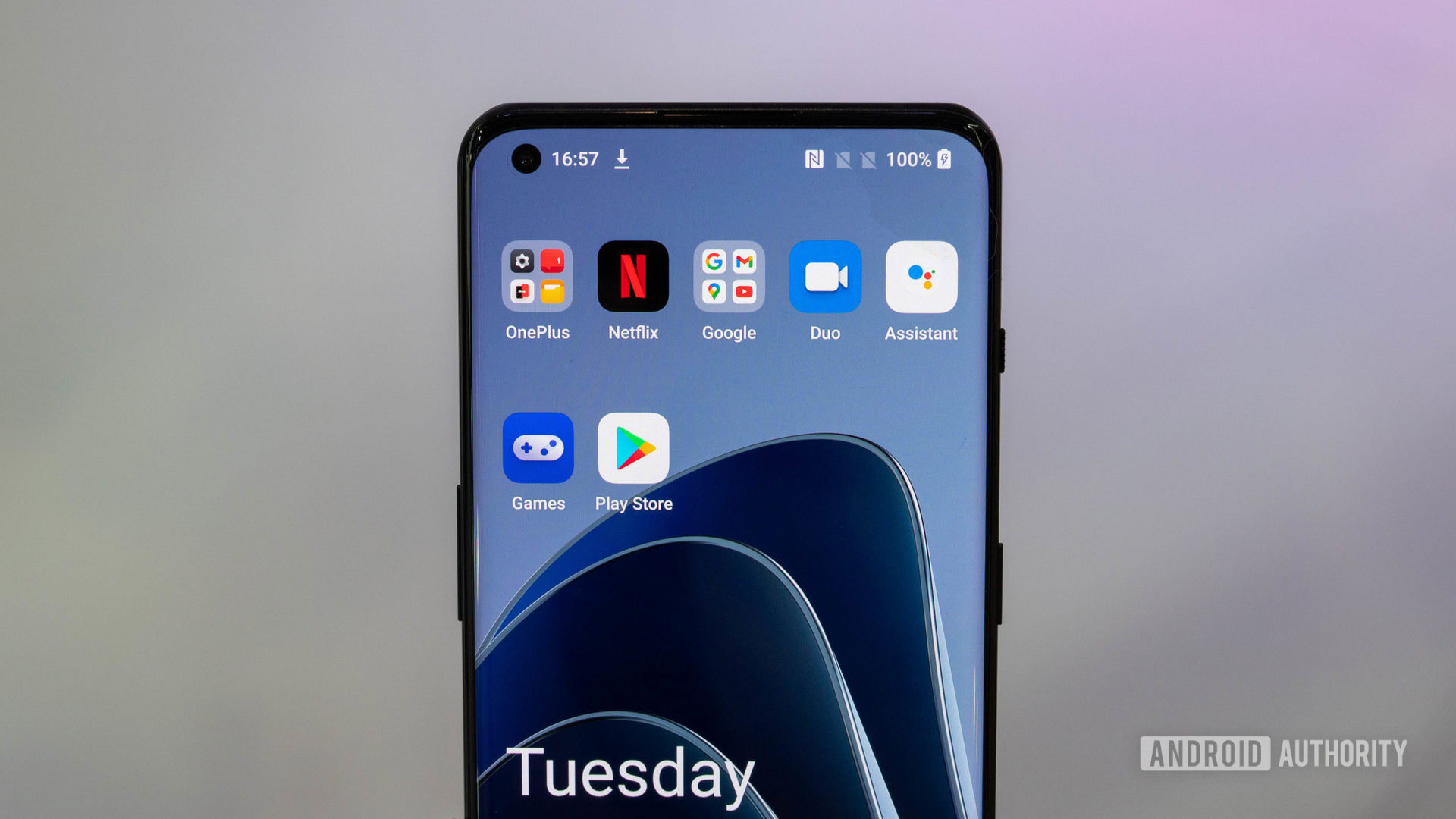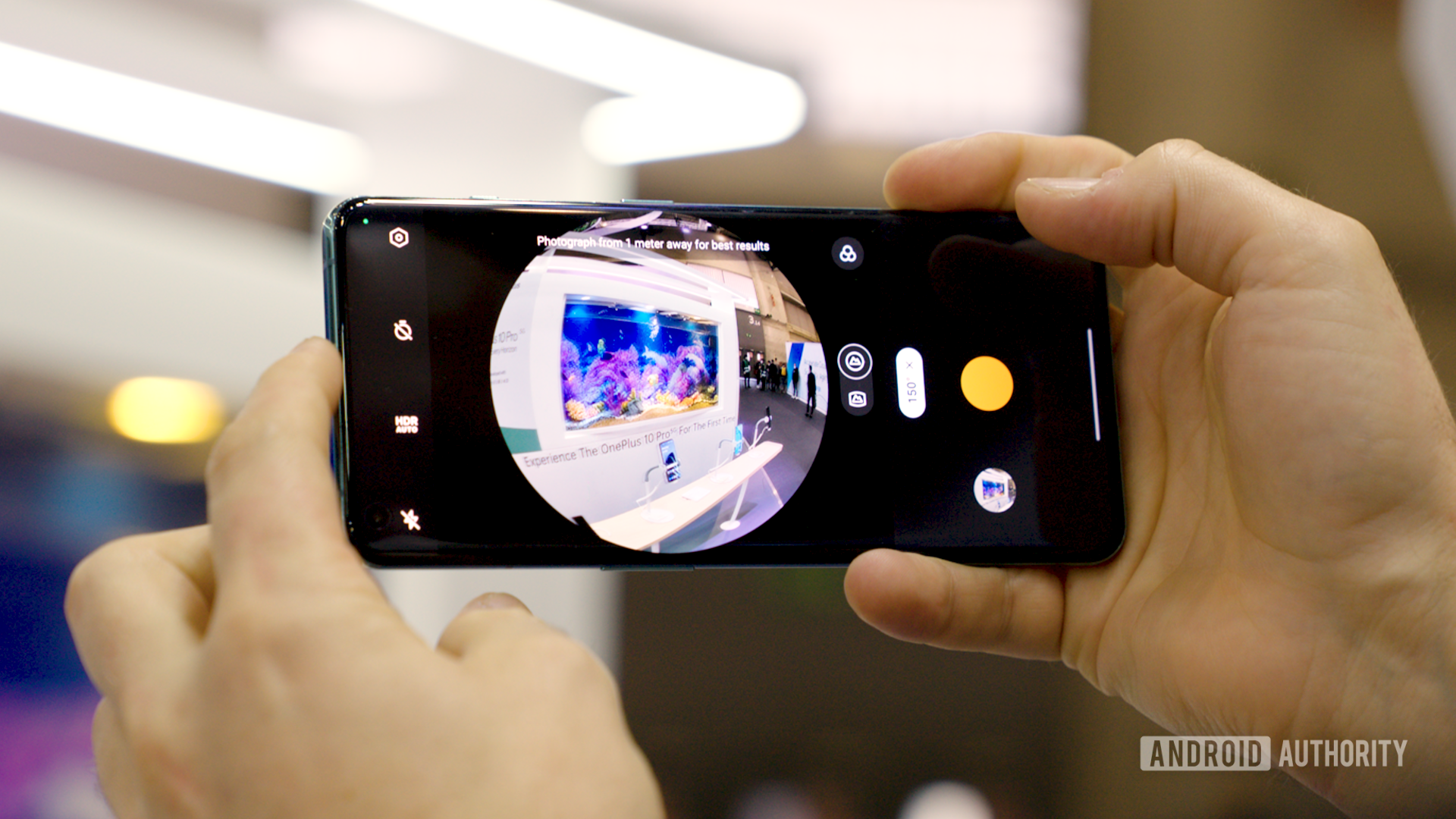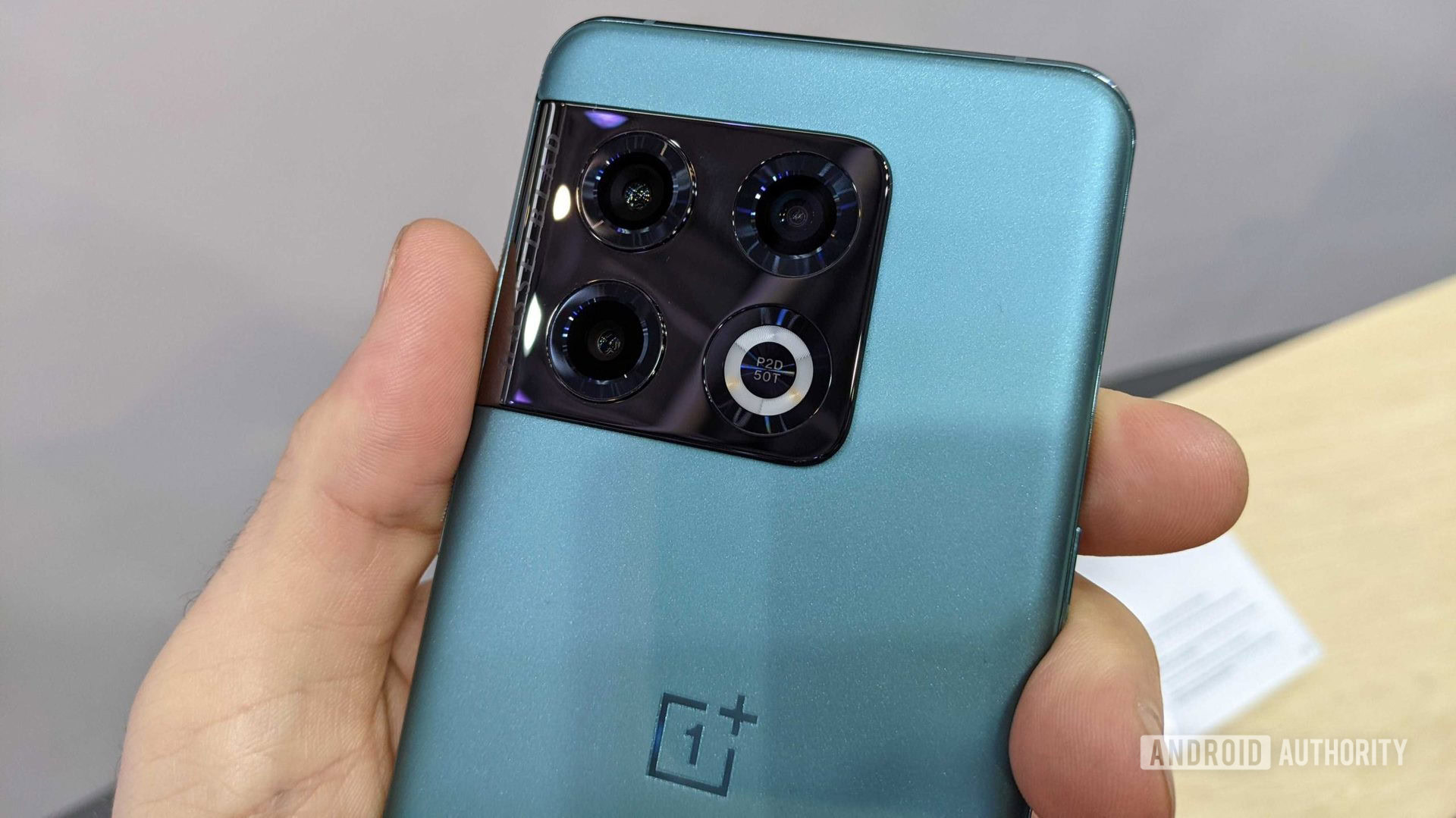Affiliate links on Android Authority may earn us a commission. Learn more.
OnePlus 10 Pro: We go hands-on with the flagship's global edition
OnePlus broke its annual tradition this year by announcing the OnePlus 10 Pro in January, which is far earlier than its previous flagship launches. It also announced the phone would land in China first, with a global rollout happening sometime later — another break with tradition. And it made sure the 10 Pro remained very shy, rarely showing up in the wild. At Mobile World Congress 2022, though, the company gave us some hands-on time with this new elusive Pro flagship.
Although the rear camera module will certainly take some getting used to, the phone overall isn’t all too different from what we’ve seen from OnePlus over the past year or so. It still looks and feels like a OnePlus flagship — for better or worse.
OnePlus 10 Pro global edition: What’s different?

Before we get into the hands-on, let’s talk about what’s different between this global version and the China-exclusive model. Originally, we were thinking OnePlus might have notable hardware differences between the Chinese and global variants, which would explain the delay. However, we now know that hardware is basically the same.
The Snapdragon 8 Gen 1 is still under the hood. There’s still up to 12GB of RAM, up to 256GB of internal storage, and a triple-lens camera on the back. There’s also a 5,000mAh battery that charges with a cable at 80W or wirelessly at 50W with the proprietary OnePlus charging stand.
Hardware-wise, the OnePlus 10 Pro you'll see globally isn't different from what landed in China in January.
Even the colorways are the same: Emerald Forest and Volcanic Black. It’s possible OnePlus could have more colors on the way, but we only saw those two at MWC.
Really, the primary difference between the OnePlus 10 Pro global model and its China-exclusive counterpart is the software. In China, OnePlus is using Oppo’s Color OS. The rest of the world will get Oxygen OS 12.1 based on Android 12. We’ll touch on that more in a bit.
Design and feel

At its MWC booth, OnePlus had a small wall with two presentations on either side. On one side, a lineup of the major flagships the company has launched since the beginning, starting with the OnePlus One all the way through to the OnePlus 9 Pro. On the other side, a bunch of OnePlus 10 Pro devices.
Going down that progression line really sent home how similar the OnePlus 10 Pro is to the 9 Pro. Since I could hold both in my hands simultaneously, it was impossible to dismiss the idea that OnePlus may have just taken the body of a OnePlus 9 Pro and swapped out the camera module. The weight, curvature, and overall feel of the 10 Pro are not all that different.
Check it out: Our original OnePlus 9 Pro review
Of course, that camera module is something else. Honestly, the more I held the phone the more it grew on me. It’s a divisive design, sure, but I am usually a fan of those kinds of things. In my mind, the more risks smartphone companies take, the better, and this isn’t really an exception.
Really, though, that module is all you need to get used to. Anyone who’s owned a OnePlus 9 Pro will feel right at home otherwise.
As far as colorways go, Emerald Forest seemed much bluer to me than the green I expected from OnePlus’ official images. It’s possible it was the harsh lighting of the MWC show floor, but the phone looks way more teal than I would expect from a phone called “Emerald Forest.” The Volcanic Black model, meanwhile, at first looks like it could be a return to the iconic Sandstone back from the OnePlus One and OnePlus 2. However, that is not the case. Although it looks textured, the back is flat, slippery glass, just like every other OnePlus flagship from the past few years.
Global model software

As mentioned earlier, the essential difference between a Chinese OnePlus 10 Pro and a global model is the software. When OnePlus first announced “OnePlus 2.0,” it said it would eventually merge its own Oxygen OS with OPPO’s Color OS. However, it changed its mind on that and will now keep Oxygen OS around. The two Android skins will still carry the same codebase, but they will look different and continue to have different features.
Oxygen OS isn't going anywhere, and what a OnePlus 9 Pro has now is not what will come with the OnePlus 10 Pro.
Notably, OnePlus told us that when global users take the OnePlus 10 Pro out of the box, it will have Oxygen OS 12.1 installed. This will be different from the current Oxygen OS 12 you can get for the OnePlus 9 and OnePlus 9 Pro. However, the company would not disclose what exactly it changed between the two versions. Clearly, enough has been modified for OnePlus to designate it with a point upgrade, but specifics are a mystery.
The model we got to try at MWC had a regular old Oxygen OS 12 installed. So I couldn’t even swipe around and try to deduce the changes for myself.
Regardless, Oxygen OS 13 might be where the big changes come. Judging from what OnePlus has announced so far about its skin based on Android 13, there could be some fanservice on the way.
Camera features: Let’s get wide

The cameras on the OnePlus 10 Pro are real head-scratchers. The wide and telephoto cameras are essentially the same as what we saw on the OnePlus 9 Pro. The monochrome sensor is gone.
Meanwhile, the ultrawide sensor is actually a weaker model than what we saw on the OnePlus 9 Pro. The company admitted this was the case, but justified the decision based on the fact that the ultrawide camera is now the widest on the market with a 150-degree FoV.
This ultra-ultrawide allows you to have a fun little fisheye lens feature, as seen above. However, it also severely warps the sides of your image when you’re using the ultrawide lens as normal. Even with just looking through the viewfinder, I could see the significant warping. Oxygen OS 12.1 might solve this problem, but the company wouldn’t confirm anything.
Related: The best camera phones you can get
OnePlus also didn’t let me save any photos taken with the phone, so you’ll need to wait for our full review for that. Overall, though, I was left unimpressed within the short time I spent with the camera. It seemed like the same stuff I saw on the OnePlus 9 Pro but with a warped ultrawide and a gimmicky fisheye lens.
OnePlus emphasized to us that the real advancement of the camera is the “Billion Color Solution,” which is marketing jargon for realistic color representation. Developed with partner Hasselblad, this should allow the camera to produce more accurate colors in photos and videos. Of course, I couldn’t do any comparisons. So for now, all I can say is that the camera doesn’t feel like a significant step up over the OnePlus 9 Pro. In fact, it seems like OnePlus is reverting back to its old gimmicky tricks rather than genuinely making a better product.
OnePlus 10 Pro hands-on: One small step for OPPO

When I visited the OnePlus booth at MWC, I laughed a little bit to myself. Rather than have its own booth, OnePlus simply had a small section of the massive OPPO booth. I’d say the OnePlus area was about 20% of the floor, with OPPO’s gear taking up the other 80%.
Honestly, this seems like a microcosm example for OnePlus at the moment. With the company formally merging into OPPO, it’s become less of a disruptor (remember “Flagship Killer?”) and more of an afterthought. My admittedly limited time with the OnePlus 10 Pro left me feeling the same way. It’s not moving the needle in any significant way for OnePlus and it takes more than a funky camera module design to set yourself apart from the pack.
Continued reading: A history of every OnePlus phone so far
I will give the company the benefit of the doubt, though. If Oxygen OS 12.1 fixes all the issues users had with Oxygen OS 12 and the company makes a ton of improvements to its ultrawide setup, this could be a great phone for OnePlus fans. However, with the 9 Pro, it felt like OnePlus was making a giant leap into the same realm as Samsung and Apple. We even said as much in our review. The OnePlus 10 Pro, so far, doesn’t give off the same vibes. Instead, it feels like OPPO dashed off what it thinks a OnePlus phone should be and called it a day.
Hopefully, my mind will be changed about this when the final version of the phone hits the global market. Until then, though, I’d recommend you wait for the reviews to see if it’s the upgrade OnePlus fans want.